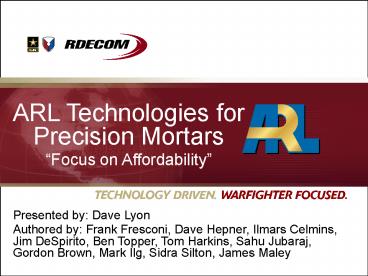ARL Technologies for Precision Mortars - PowerPoint PPT Presentation
1 / 19
Title:
ARL Technologies for Precision Mortars
Description:
Provide detailed understanding and high-fidelity M&S capability ... (Understanding of on-board measurements, fusion to reduce burden & increase fidelity) ... – PowerPoint PPT presentation
Number of Views:852
Avg rating:5.0/5.0
Title: ARL Technologies for Precision Mortars
1
ARL Technologies for Precision Mortars Focus on
Affordability
Presented by Dave Lyon Authored by Frank
Fresconi, Dave Hepner, Ilmars Celmins, Jim
DeSpirito, Ben Topper, Tom Harkins, Sahu Jubaraj,
Gordon Brown, Mark Ilg, Sidra Silton, James Maley
2
Why Affordable Precision?
- Background
- Numerous requirements for precision projectiles
exist - Precision munitions have proven valuable on the
battlefield, but at a cost that limits their
proliferation - Goal
- Provide Warfighter with solutions that are
precise, responsive, lethal and affordable
allowing engagements that are not possible today
(urban canyon, reverse slope, low collateral
damage)
3
Why Affordable Precision?
- Plan of Attack
- Examine cost drivers G,NC occupies gt60 of
UPC - Embrace approaches that take advantage of
ballistic properties instead of designing around
them - Provide detailed understanding and high-fidelity
MS capability - Develop government expertise and IP, transition
to industry - Focus on technologies that enable cross-caliber
solutions - Implementations
- Very Affordable Precision Projectile (VAPP)
- 120mm Mortar, 105mm and 155mm Arty
- Flight Controlled Mortar (FCM)
- 81mm Mortar
4
Where to Invest?(Affordable Precision)
Three basic guidance questions Where am I?
Where do I need to go?
How do I get there?
Vehicle State Determination 12 states time
(position, angle, velocity, angular rates, t)
GN Algorithms Impact Point Predictors,
Trajectory Trackers, Terminal Homing
Maneuver Systems Means, mechanisms controls
Vehicle State Estimation (Understanding of
on-board measurements, fusion to reduce burden
increase fidelity)
Reduced State G,NC Algorithms (Simplest
solutions to get to target Impact Point
Predictors, Linear Theory, PRESIMEN)
Affordable Actuators (Simplest mechanisms and
controls to execute maneuvers)
Magnetic Navigation (Use earths mag field to
provide angular states)
Advanced Aero Prediction Methods (Fast turn
generation of aero coefficients that allow
up-front optimization)
Unsteady/Non-Linear Aerodynamics (Aero prediction
of dynamic derivatives and non-linear aero of
guided flight bodies)
Non-GPS Navigation (Derive vehicle states using
polarized RF beacons passive antennas on
projectiles)
5
Modeling the Aerodynamics of Mortars
- Mortar aerodynamics can be highly nonlinear,
primarily due to the interaction of the afterbody
wake with the stabilizing fins - Effect inherent of the long boattail and boom
- Ability to understand and predict these behaviors
is key
6
Understanding Complex Flight Dynamics
Time-dependent flow field depicts canard
interaction with tail fins
7
Embracing Projectile Dynamics to Simplify the
Guidance Problem
- Guidance, Navigation, and Control System
- Traditional approach
- Navigation Coupled GPS IMU
- GPS provides initialization and correction of IMU
- IMU provides states needed for guidance and
dynamic stability - Guidance Control - proportional
navigation/homing - Alternate solution
- Navigation - GPS provides states needed for
reduced-state guidance and aerodynamics provides
dynamic stability - Guidance Control - Impact point predictor
guidance exploits fundamental aerodynamics/flight
mechanics - Weakness needs GPS to function
8
Integrated Modeling Environment(Building the
Toolkit)
3-D Kinematic Simulation
FEA using loading from kinematic simulation at a
given time step
- Prescribed linear motor displacement (bottom left
graph) - Required force (top left) and power (bottom
right) profiles required to achieve desired
displacement history
9
Simple Maneuver Mechanism
- Traditional Solutions
- 3 or 4 independent servo-controlled canards
provide roll control and lateral maneuver
(missile, Excalibur) - Impulse thrusters to generate angle of attack
(PGMM) - Fixed canards rolled into plane of maneuver
(PGK) - VAPP Maneuver Solution
- Single pair of canards actuated by a Linear
Voice Coil (LVC) - Canards dither in rolling airframe to provide
control authority (control authority maximized
with control mechanism at nose)
10
VAPP CAS Operation
11
HIL - PREcision SIMulation ENvironment (PRESIMEN)
V
Acc. I
Launch
RF
12
VAPP 120mm Mortar in PRESIMEN
13
Integrating VAPP Technologies for a Tech Demo
- Optimized G,NC with actuator
- Electrical design
- Algorithms embedded on digital signal processor
(DSP) - H-bridge driven by pulse width modulation
- Encoder and zero-crossing sensors provide
feedback - Controller algorithm
- LQR controller tracks sinusoidal reference signal
Initial controller performance and power
requirements from HIL/CFD
Assessment of aero-heating on electronics
Controller performance and power requirements
verified in wind tunnel
14
CAS Verification
- Supporting analyses
- Computational Structural Dynamics
- Computational Fluid Dynamics
- 6 degree-of-freedom (6DOF) modeling
- Interior ballistics modeling
- Experimental confirmation
Radar data from flight testing agrees with CFD
15
Pre-Programmed Flight
- Demonstrate CAS, on-board electronics and
quantify maneuverability - Muzzle Velocity 300 m/s Elevation 15 deg
- Telemetry used to verify response of actuator
- Radar used to quantify increase in range from
ballistic flight test
30 range increase achieved by glide
16
120mm Mortar VAPP (Proof-of-Principle)
17
Aerodynamic Optimization for FCM
- Beveled fin force predictions
- Canard aspect ratio (AR) effects
- Canard cross section (airfoil) shape effects
- Non-conventional canards (grid fin)
Fin Bevel Effects
18
CAS for FCM
- Derivative of initial VAPP design
- Canards stowed until maneuver is needed
19
Summary and Conclusions
- Developing cost-effective guided projectile
solutions - Technology is caliber independent
(fin-stabilized projectiles) - Generating govt expertise and Intellectual
Property - High fidelity Modeling Simulation toolkit
- Tapping strengths from across DoD
- Army (ARDEC, PM-CAS)
- Navy (NSWC-D and IH)
- Industry (CRADAs and contracts)
- Developing Technology Transition Plan (ARDEC to
lead) - Questions?































